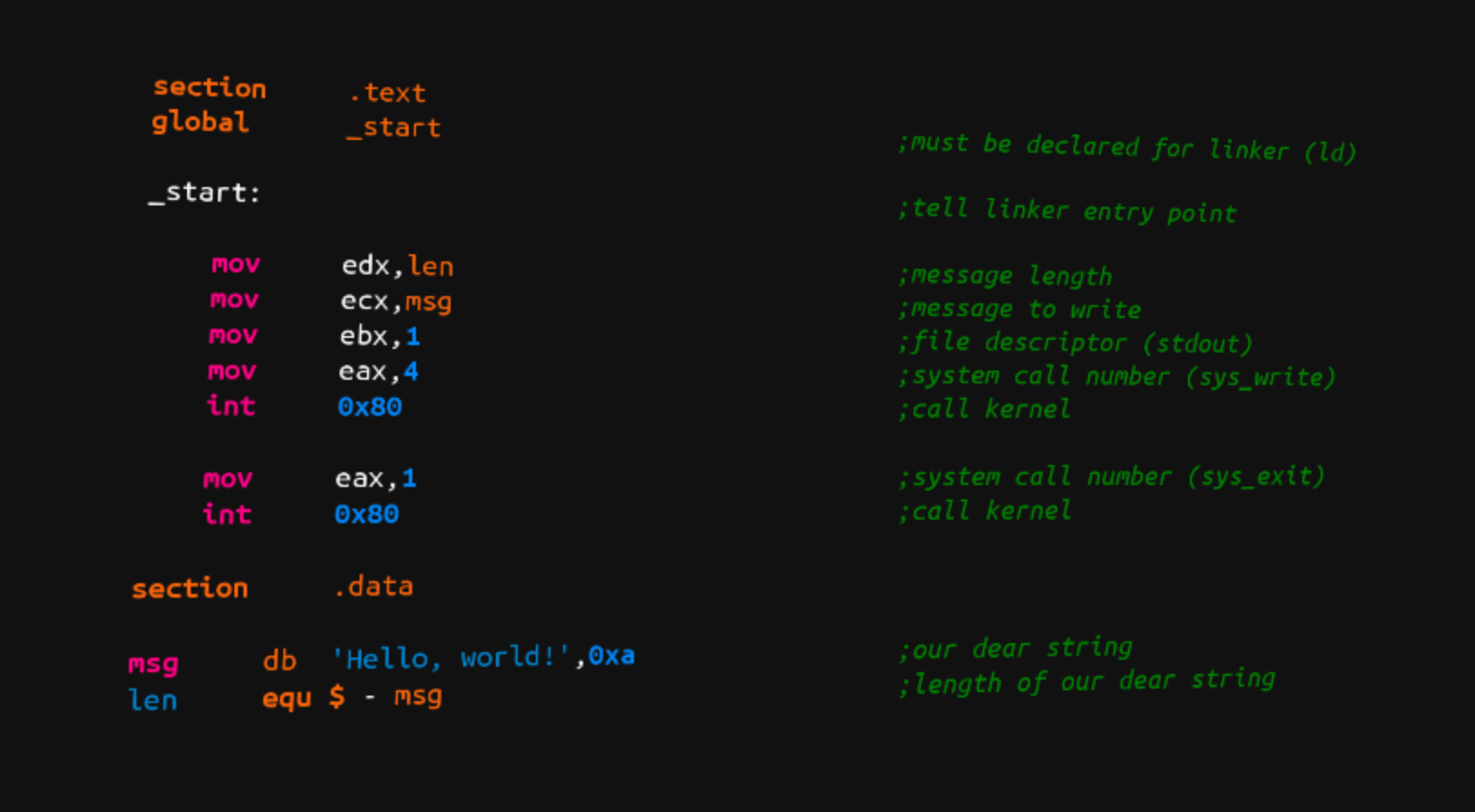
Assembly From Zero
General-Purpose Registers
There are 8 main general-purpose registers:
RAX: Accumulator register. Often stores the return value of a function.RBX: Sometimes used as a base register (not to be confused with the base pointer).RCX: Counter register, commonly used as a loop counter.RDX: Known as the data register.RSI: Source index, used as the source pointer in string operations.RDI: Destination index, used as the destination pointer in string operations.RSP: Stack pointer, holds the address of the top of the stack.RBP: Base pointer, holds the address of the base (bottom) of the stack.
Extra Registers
R8: Full 64-bit (8 bytes) register.R8D: Lower double word (4 bytes).R8W: Lower word (2 bytes).R8B: Lower byte.
Instructions Overview
Operand Types
- Immediate: Constant value (e.g.,
12) — not a memory address or register. - Register: Refers to registers like
RAX,RBX,R12,AL, etc. - Memory Address: A location in memory (e.g.,
0x7FFF842B).
Instruction Format
(Instruction / Opcode / Mnemonic) ,
mov RAX, 5 ; RAX = 5
lea RAX, num1 ; RAX = address of num1
LEA vs MOV
LEA (Load Effective Address)
LEA RAX, [10] ; RAX = 10 (not a memory read)
Used for address computation:
RCX = 0x1000
LEA RAX, [RCX + 8] ; RAX = 0x1008
MOV (Memory Read)
MOV RAX, [10] ; RAX = value at memory address 0xA
RCX = 0x1000
[0x1008] = 0x12345678
MOV RAX, [RCX + 8] ; RAX = *(0x1008) = 0x12345678
Tip: Square brackets
[ ]dereference memory addresses inMOV, but not inLEA.
Conditional Branching: The JMP's Mason
Unsigned Comparisons
| Instruction | Condition | Flags |
|---|---|---|
JB / JNAE | Jump if Below / Not Above or Equal | CF = 1 |
JAE / JNB | Jump if Above or Equal / Not Below | CF = 0 |
JBE / JNA | Jump if Below or Equal / Not Above | CF = 1 or ZF = 1 |
JA / JNBE | Jump if Above / Not Below or Equal | CF = 0 and ZF = 0 |
Signed Comparisons
| Instruction | Condition | Flags |
|---|---|---|
JL / JNGE | Jump if Less / Not Greater or Equal | SF ≠ OF |
JGE / JNL | Jump if Greater or Equal / Not Less | SF = OF |
JLE / JNG | Jump if Less or Equal / Not Greater | ZF = 1 or SF ≠ OF |
JG / JNLE | Jump if Greater / Not Less or Equal | ZF = 0 and SF = OF |
If-Else: Compiler Translation Example
if(x == 4){
func1();
} else {
return;
}
The compiler might generate:
if(x != 4){
goto __exit;
}
func1();
__exit:
return;
Compiler Optimization: Compilers flip logic to reduce jumps and instructions for efficiency.
Pointers in Assembly
- Square brackets
[ ]dereference memory addresses.
MOV RAX, [10] ; RAX = *(0xA)
LEA RAX, [10] ; RAX = 10 (no memory read)
[var]means value at the address held by var
let RCX = 0x1000
let Memory at 0x1008 = 0x12345678
MOV RAX, [RCX + 8] ; RAX = *(0x1000 + 8) = *(0x1008)
; RAX = 0x12345678
Flags
Flags are contained in a register called EFLAGS (x86) or RFLAGS (x64)
There is an actual FLAGS register that is 16 bit, but the semantics are just a waste of time.
Status Flags
Here are the flags you should know. Note that when I say a "flag is set" I mean the flag is set to 1 which is true/on. 0 is false/off.
- Zero Flag (ZF) - Set if the result of an operation is zero. Not set if the result of an operation is not zero.
- Carry Flag (CF) - Set if the last unsigned arithmetic operation carried (addition) or borrowed (subtraction) a bit beyond the register. It's also set when an operation would be negative if it wasn't for the operation being unsigned.
- Overflow Flag (OF) - Set if a signed arithmetic operation is too big for the register to contain.
- Sign Flag (SF) - Set if the result of an operation is negative.
- Adjust/Auxiliary Flag (AF) - Same as the carry flag but for Binary Coded Decimal (BCD) operations.
- Parity Flag (PF) - Set to 1 if the number of bits set in the last 8 bits is even. (10110100, PF=1; 10110101, PF=0)
- Trap Flag (TF) - Allows for single-stepping of programs.
EXAMPLES
mov RAX, 4
cmp RAX, 4
jne 5 ; Line 5 (ret)
call func1
ret ; ZF = 1, OF = 0, SF = 0
mov RAX, 2
sub RAX, 8 ; 2 - 8 = -6 ; ZF = 0, OF = 0, SF = 1
mov AL, 75
add AL, 60
; ZF = 0, OF = 1, SF = 1
